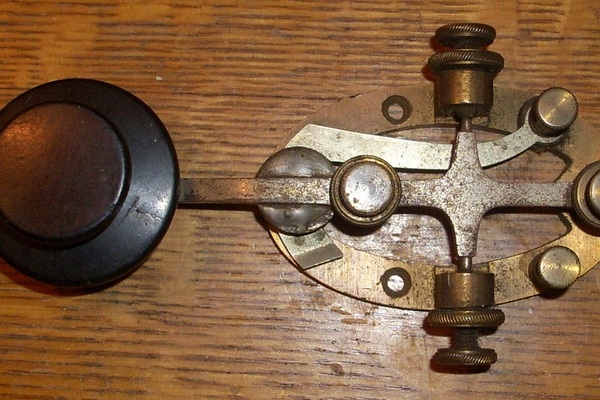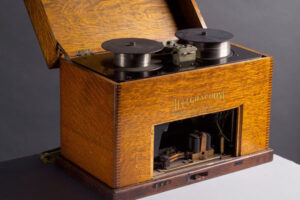Broadcasting is a revolutionary form of communication that allows information and entertainment to reach a wide audience. In the early days of broadcasting, the quality of audio transmissions was limited, hindering the overall listening experience. However, there is one forgotten revolution that significantly improved broadcasting: Fessenden’s Archeophone. This remarkable invention by Reginald Fessenden brought about a forgotten revolution in the broadcasting industry, enhancing audio quality and making radio broadcasts more accessible to the public.
Table of Contents
Background Information on Broadcasting
Before the advent of Fessenden’s Archeophone, broadcasting involved various forms of communication. In the early 20th century, Morse code was used to transmit messages, followed by telegraphy and telephone transmissions. However, it was not until the invention of radio that broadcasting truly took off. Radio transmissions allowed for voice communication over long distances, revolutionizing the way society connected and entertained itself.
Life and Work of Reginald Fessenden
Reginald Fessenden, a Canadian inventor and electrical engineer, played a crucial role in the development of broadcasting. Born in 1866, Fessenden’s contributions to the field of electrical engineering were immense. Prior to his invention of the Archeophone, Fessenden had already established himself as a reputable inventor, with a track record of successful innovations.
The Invention of the Archeophone
Fessenden’s Archeophone was a groundbreaking invention that improved the audio quality of radio transmissions. This ingenious device allowed for clearer and more faithful reproduction of sound, revolutionizing the listening experience for radio audiences. By emphasizing audio clarity and fidelity, Fessenden’s Archeophone transformed broadcasting from a distortion-ridden system to a more immersive and enjoyable form of entertainment.
The Forgotten Revolution
Despite its significant impact on broadcasting, the revolution brought about by Fessenden’s Archeophone has been largely overlooked. The Archeophone paved the way for improved audio quality in radio broadcasts, making them more accessible and enjoyable for the general public. Its contribution to the advancement of broadcasting cannot be underestimated, as it laid the foundation for the high-quality transmissions we enjoy today.
Background Information on Broadcasting
The concept of broadcasting has come a long way since its earliest forms. Broadcasting refers to the transmission of audio or video content to a wide audience. It has revolutionized communication and entertainment by allowing information and entertainment to reach the masses.
In its early days, broadcasting took various forms. Initially, it began with the transmission of telegraph messages across long distances. This allowed for the dissemination of news and information across vast areas, eliminating the need for physical delivery. However, it was limited to text-based communication and had not yet tapped into the potential of audio transmission.
The evolution of radio transmission played a pivotal role in the development of broadcasting. From the invention of the telegraph, it gradually progressed to include telephony, which allowed for voice transmission over considerable distances. However, it was Reginald Fessenden’s Archeophone that truly brought about a revolution in broadcasting.
Broadcasting had a profound impact on both communication and entertainment. Prior to its advent, information dissemination was largely limited to print media and in-person communication. Broadcasting allowed for real-time news updates, sharing of live events, and the provision of entertainment to a wide audience. It bridged the gap between people, making knowledge and entertainment accessible to all.
As broadcasting evolved, it became an integral part of society and culture. Radio broadcasts brought people together, providing a platform for public discourse and entertainment. The impact of broadcasting can still be seen today, with television, internet streaming, and podcasting taking center stage as the modern forms of broadcasting.
In summary, the early forms of broadcasting laid the groundwork for what we know today. From telegraph messages to voice transmission, broadcasting opened a world of possibilities in communication and entertainment. The evolution of radio transmission paved the way for the forgotten revolution brought about by Fessenden’s Archeophone. Through improved audio quality and accessibility, his invention revolutionized broadcasting and left a lasting impact on the field.
Life and Work of Reginald Fessenden
Reginald Fessenden was a pioneering figure in the field of electrical engineering, who made significant contributions to the development of broadcasting. Born in 1866 in Quebec, Canada, Fessenden’s early interest in science and technology led him to pursue a career in engineering. He studied at Bishop’s College in Lennoxville, Quebec, and later at the University of Toronto, where he specialized in electrical engineering.
Fessenden’s brilliance and innovative thinking soon became evident in his work. He was not only a skilled engineer but also a gifted inventor. His previous inventions, such as the wireless telegraph and the electrolytic detector, had already established his reputation in the field. These inventions laid the foundation for the later development of radio communication.
In 1902, Fessenden joined the National Electric Signaling Company, where he continued to experiment and improve upon existing technology. It was during this time that he developed the idea for the Archeophone, a device that would revolutionize broadcasting.
Fessenden’s Archeophone was a breakthrough in audio transmission. It used a combination of resonators, transformers, and specially designed microphones to enhance the sound quality of radio transmissions. The Archeophone was able to reproduce music and speech with remarkable clarity and fidelity, which was a significant improvement from the static-filled audio that was common at the time.
Fessenden’s contribution to the field of electrical engineering extended beyond the Archeophone. He also played a key role in the development of amplitude modulation (AM) radio, which became the basis for wireless telegraphy and modern broadcasting. His innovative work paved the way for the radio technology we have today.
Despite his groundbreaking inventions and accomplishments, Fessenden’s contributions have often been overlooked in the history of broadcasting. This is due, in part, to the fact that his inventions were overshadowed by the commercial success of other radio pioneers. However, modern scholars and researchers have begun to recognize and appreciate Fessenden’s immense contributions to the field.
In conclusion, Reginald Fessenden was an exceptional engineer and inventor who played a crucial role in the revolution of broadcasting. His Archeophone and other inventions significantly improved the quality of audio transmission and paved the way for modern radio technology. It is important to remember and recognize Fessenden’s contributions, as they continue to influence and shape the broadcasting industry to this day.
The Invention of the Archeophone
Fessenden’s Archeophone was a groundbreaking invention that revolutionized the broadcasting industry. It was a device that significantly improved the audio quality during radio transmissions, making broadcasts more accessible and enjoyable for the public.
The Archeophone can be described as a precursor to modern-day speakers. It utilized a combination of a carbon microphone and an electromagnet to convert sound waves into electrical signals. These signals were then amplified and played through a horn, producing clear and high-quality audio.
Reginald Fessenden, a renowned electrical engineer, was motivated to create the Archeophone after realizing the limitations of existing broadcasting technology. He aimed to enhance the audio quality and fidelity of radio transmissions, allowing listeners to fully immerse themselves in the broadcasted content.
The significance of the Archeophone cannot be overstated. It played a crucial role in improving the overall audio experience for listeners. Prior to its invention, radio transmissions suffered from poor sound quality and distortion. The Archeophone’s advanced technology and design greatly enhanced the clarity and fidelity of audio, revolutionizing the entire broadcasting industry.
With the Archeophone, radio broadcasts became more immersive, engaging, and accessible to the public. People could now listen to music, news, and entertainment programs with unprecedented clarity. The Archeophone’s ability to reproduce and amplify sound allowed the content to reach a wider audience, further solidifying its importance in the evolution of broadcasting.
In conclusion, the invention of Fessenden’s Archeophone marked a significant milestone in the revolution of broadcasting. Its role in enhancing audio quality and making radio broadcasts more enjoyable cannot be overlooked. The Archeophone played a crucial part in shaping the broadcasting industry as we know it today and deserves recognition for its enduring influence.
The Forgotten Revolution
The invention of Fessenden’s Archeophone had a profound impact on the broadcasting industry, yet it often goes unnoticed in the annals of history. This forgotten revolution brought about significant changes in the field, revolutionizing the way audio was transmitted and received.
Fessenden’s Archeophone revolutionized broadcasting by greatly improving audio clarity and fidelity. Unlike previous methods of transmission, this invention allowed for a more precise and accurate reproduction of sound. The Archeophone enhanced the audio quality during radio transmissions, making it a key factor in the development of modern broadcasting.
With the Archeophone, Fessenden made radio broadcasts more accessible to the public. The improved clarity and fidelity provided by the invention allowed listeners to enjoy a more immersive experience when tuning in. This, in turn, increased public interest and engagement with radio, ultimately leading to the widespread adoption of this medium of communication and entertainment.
The role of the Archeophone in making radio broadcasts more accessible cannot be overstated. Its ability to capture and reproduce sound with exceptional clarity made it possible for listeners to feel as though they were part of the experience. This made radio a more inclusive and enjoyable medium for people from all walks of life, regardless of their location or social standing.
Despite its groundbreaking contributions to the field, the Archeophone is often overlooked in broadcasting history. This oversight can be attributed to several factors, including the rapid advancements in technology that followed Fessenden’s invention. As newer, more sophisticated broadcasting technologies emerged, the significance of the Archeophone began to fade from public consciousness.
However, today, efforts are being made to acknowledge and restore Fessenden’s work. Modern scholars and enthusiasts recognize the importance of his forgotten revolution. They understand that his invention laid the foundation for the advancements we see in broadcasting today, and they strive to ensure that Fessenden’s contributions are not forgotten.
In conclusion, Fessenden’s Archeophone brought about a forgotten revolution in broadcasting. Its impact on the industry cannot be understated, as it significantly improved audio clarity and fidelity, making radio broadcasts more accessible to the public. By remembering and recognizing Fessenden’s contributions, we acknowledge the enduring influence of his forgotten revolution and the role it played in shaping the modern world of broadcasting.
Legacy and Recognition
While Reginald Fessenden’s Archeophone brought about a revolution in broadcasting, its initial reception and recognition were not as widespread as one would expect. The significance of this invention often goes overlooked in broadcasting history, overshadowed by other well-known advancements. However, in recent years, there have been efforts to acknowledge and restore Fessenden’s work.
Initially, Fessenden’s invention received some attention and recognition within the scientific community. His colleagues and contemporaries recognized the breakthrough nature of the Archeophone and its potential impact on the field of broadcasting. However, due to a combination of factors such as limited resources, competition, and changing interests, the Archeophone’s recognition did not extend beyond a small circle of experts.
The oversight of Fessenden’s Archeophone in broadcasting history can be attributed to several reasons. Firstly, Fessenden was not as commercially successful as some of his contemporaries, which directly impacted the level of recognition his invention received. Additionally, the Archeophone was not widely adopted or marketed on a large scale, as Fessenden faced financial constraints and licensing difficulties.
However, in recent times, there has been a growing acknowledgment of Fessenden’s contributions to broadcasting. With the advent of modern technology and increased interest in historical innovations, there have been efforts to restore and reconstruct Fessenden’s Archeophone. These restoration projects aim to recreate the original sound quality and experience that Fessenden intended. These efforts highlight the importance of recognizing and preserving Fessenden’s forgotten revolution in broadcasting.
In conclusion, while the initial recognition of Fessenden’s Archeophone may have been limited, there is an ongoing effort to acknowledge its significance in the history of broadcasting. Through restoration projects and the rediscovery of Fessenden’s work, there is a growing recognition of his contributions to the field. It is essential to remember and honor Fessenden’s forgotten revolution, as it serves as a reminder of the enduring influence and innovation that can come from often overlooked inventions.
Conclusion
The invention of Fessenden’s Archeophone marked a pivotal moment in the history of broadcasting. This groundbreaking device revolutionized radio transmissions, propelling the field into new realms of audio clarity and fidelity. However, despite its significant contributions, the Archeophone has been largely overlooked in the annals of broadcasting history.
Fessenden’s Archeophone played a crucial role in enhancing the quality of audio during radio broadcasts. Its innovative design and incorporation of advanced technology allowed for improved clarity and the faithful reproduction of sound. This breakthrough not only elevated the overall listening experience for audiences but also paved the way for further advancements in broadcasting.
It is essential to remember and recognize Fessenden’s monumental contributions to the field of broadcasting. His invention brought about a forgotten revolution that forever transformed the way we communicate and entertain. Without the Archeophone, the broadcasting industry would not have witnessed the same level of audio excellence and accessibility that we enjoy today.
In conclusion, Fessenden’s Archeophone stands as a testament to the enduring influence of his forgotten revolution. This remarkable device played a pivotal role in shaping the broadcasting industry and deserves its rightful place in history. As we continue to advance technologically, it is crucial to acknowledge the contributions of individuals like Fessenden, whose innovations have had a lasting impact on our lives. Let us remember the forgotten revolution brought about by Fessenden’s Archeophone and celebrate its enduring legacy.




